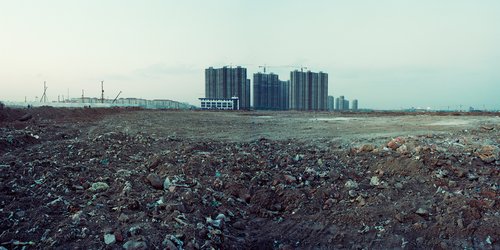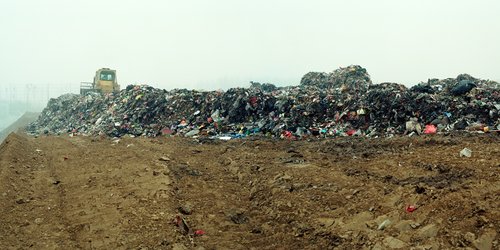A photography series named "Rubbish-besieged City" by Wang Jiuliang, a 34-year-old Golden Award winner for Excellent Artist at the 2009 Lianzhou International Photography Festival, has attracted much public attention since it was posted on Tianya.cn, a popular Chinese Web forum.
The series not only sketched out the capital's "seventh ring" formed by over 400 illegal rubbish dumps, but also uncovered a profitable business dependent on the landfills – trash recycling.
A city surrounded by trash
"I don't want the award to bring honor to myself. I would rather society realize the fact that we are living in a city surrounded by trash. I want to raise environmental awareness in every citizen's mind. That would be the best prize for my work," said Wang, who has visited more than 400 landfills around Beijing since 2008.
Yellow labels denote landfills on the outskirts of the capital mapped out by Wang, which form the "seventh ring." Most of landfills are run by private contractors and not under the management of the Beijing environment and sanitation system.
One of Wang's pictures was taken at a landfill in Mujuqiao, Tongzhou District. The 300-mu (49 acre) and seven-meter-deep dump was created by local villagers and has been operated by private persons since 2009. Small houses inhabited by junkmen and waste recyclers can be seen at the rim of the pit.
By the end of June, Wang's series of pictures had received more than 130,000 visits and over 700 comments, a clear sign of public concern about the garbage disposal issue across the country.
"Almost every river is polluted in my hometown in Anhui Province," a netizen said. "The pond is glutted with rubbish."
After the pictures were exhibited, Wang found that half of the illegal landfills had been cleared. Yet 30 percent remained unchanged.
Profit chain behind landfills
Attached to the rubbish dumps is a profitable waste recycling business, Wang said, and over one third of the landfills were operated under lease.
"The administrators of the landfills are contractors. They rent the pits from the villages and then sublet them to us," a waste operator from Xinyang, Henan Province, told the Economic Observer. "Most waste operators here are from Xinyang."
The pits are dug by villagers and then rented out to contractors, mostly local people. Unlike legal landfills, the illegal ones are cheaper to run, since rubbish is dumped without measures such as dust prevention or anti-leakage, which are required by official landfills.
Truckloads of rubbish can bring up to hundreds of yuan, but the most lucrative business comes from waste recycling. Landfill contractors sublet the landfills to recyclers, and earnings are shared between contractors and recyclers after rubbish has been sorted and recyclable materials are sold.
The grey business has destroyed many things, Wang recalled. A profitable fishpond was turned into a landfill because the owner could earn more. Wetlands and paddy fields have also become landfills. "Some people care about nothing except earning money," Wang sighed.
What to do with the garbage?
Some experts believe that for big cites like Beijing, with its huge population and limited land resources, burning would be a better choice than dumping, even though it is not the best choice for disposing waste.
"Compared with dumping, burning waste could save 90 percent of land resource," said Wang Weiping, an expert on garbage disposal.
Ma Da, a doctor at Beijing Normal University, suggested that the government should invest more in garbage classification.
Although garbage classification has been carried out in Beijing for many years, the effect is limited. "Even though different dustbins are used for garbage classification, the dust carts mix all the rubbish together," according to one netizen.
The government should include waste recycling and disposal problems into its overall city planning, experts suggested.
"The best way is to produce less garbage," one netizen said. "The second best is to change the garbage into a useful resource. The last is to build environmentally friendly disposal plants."



















